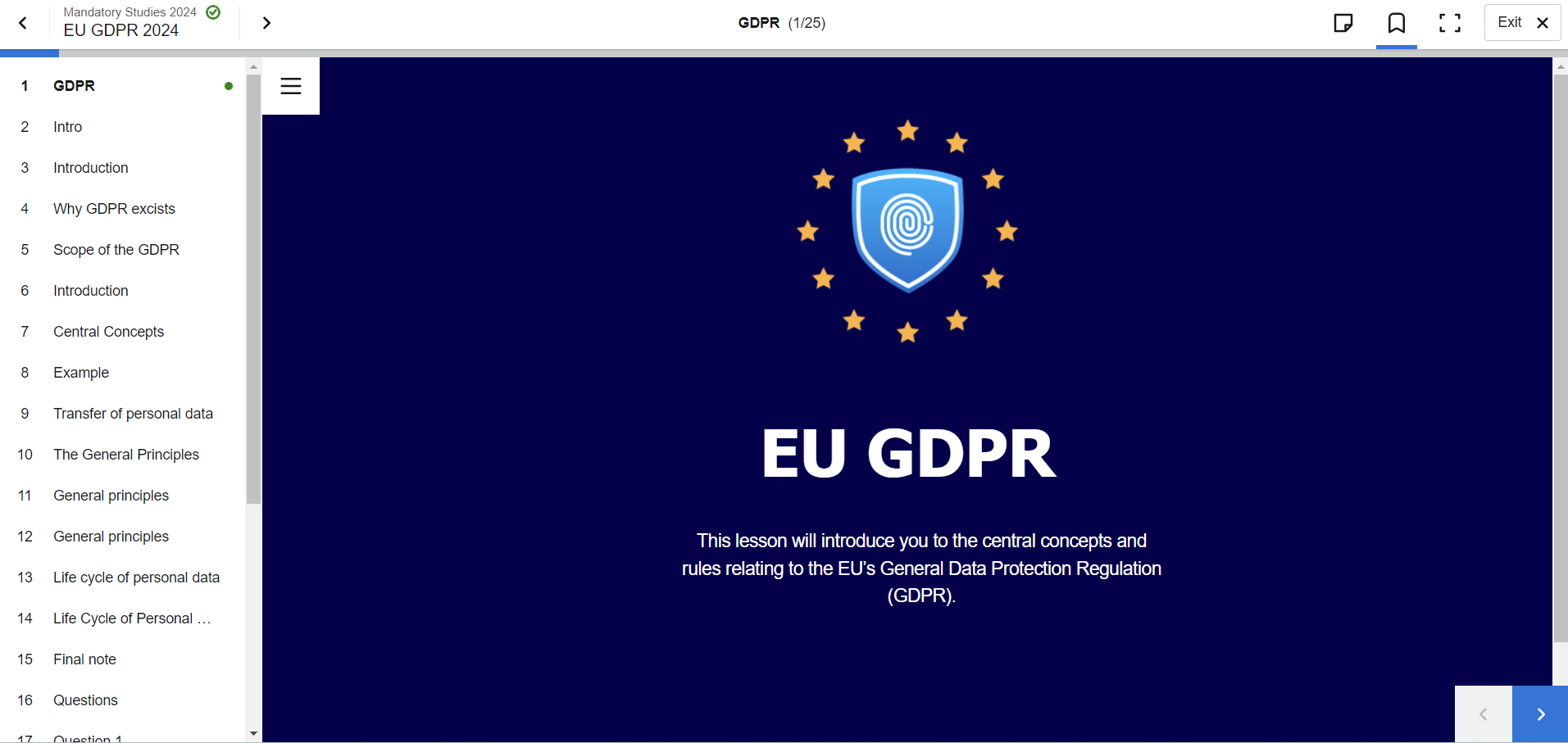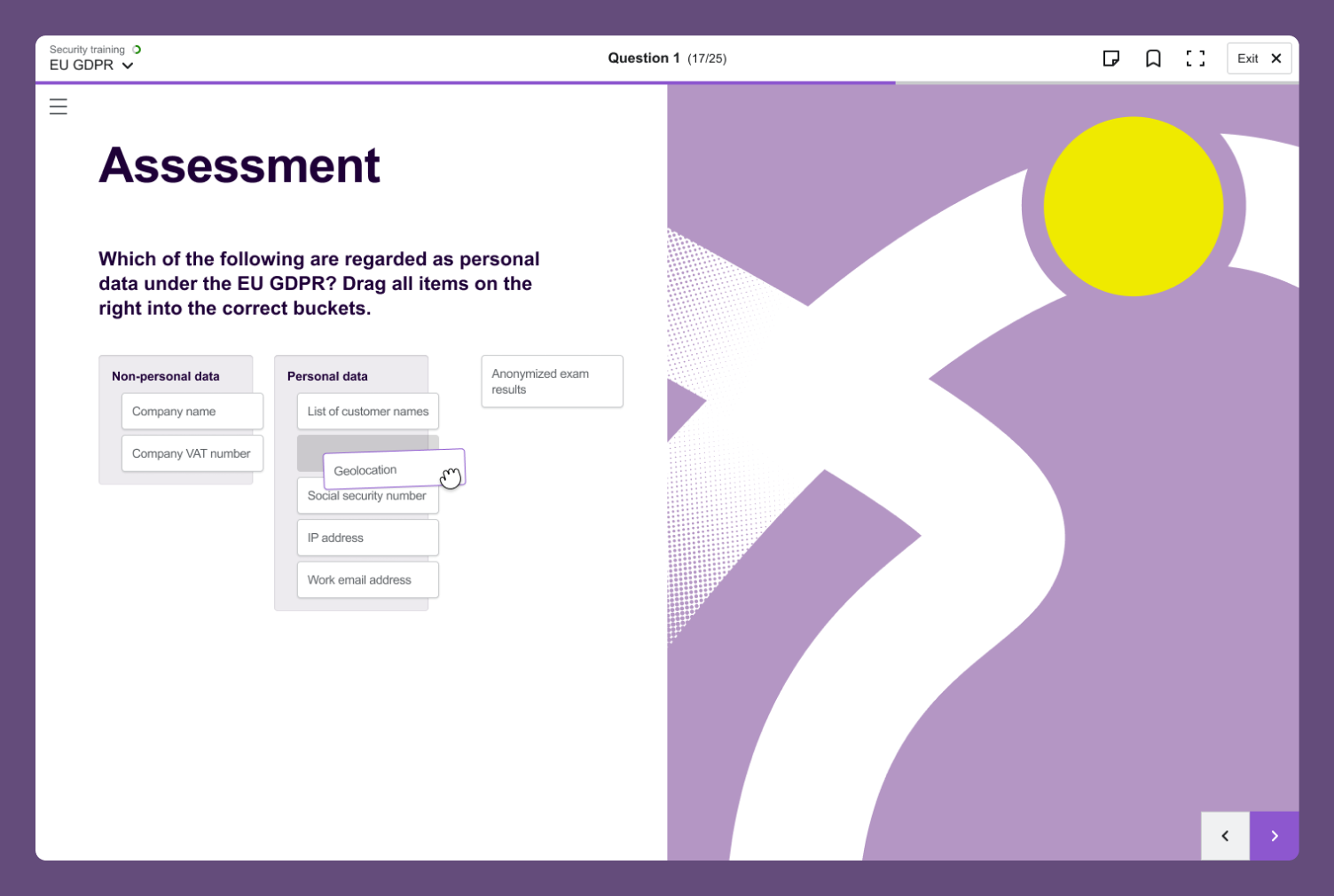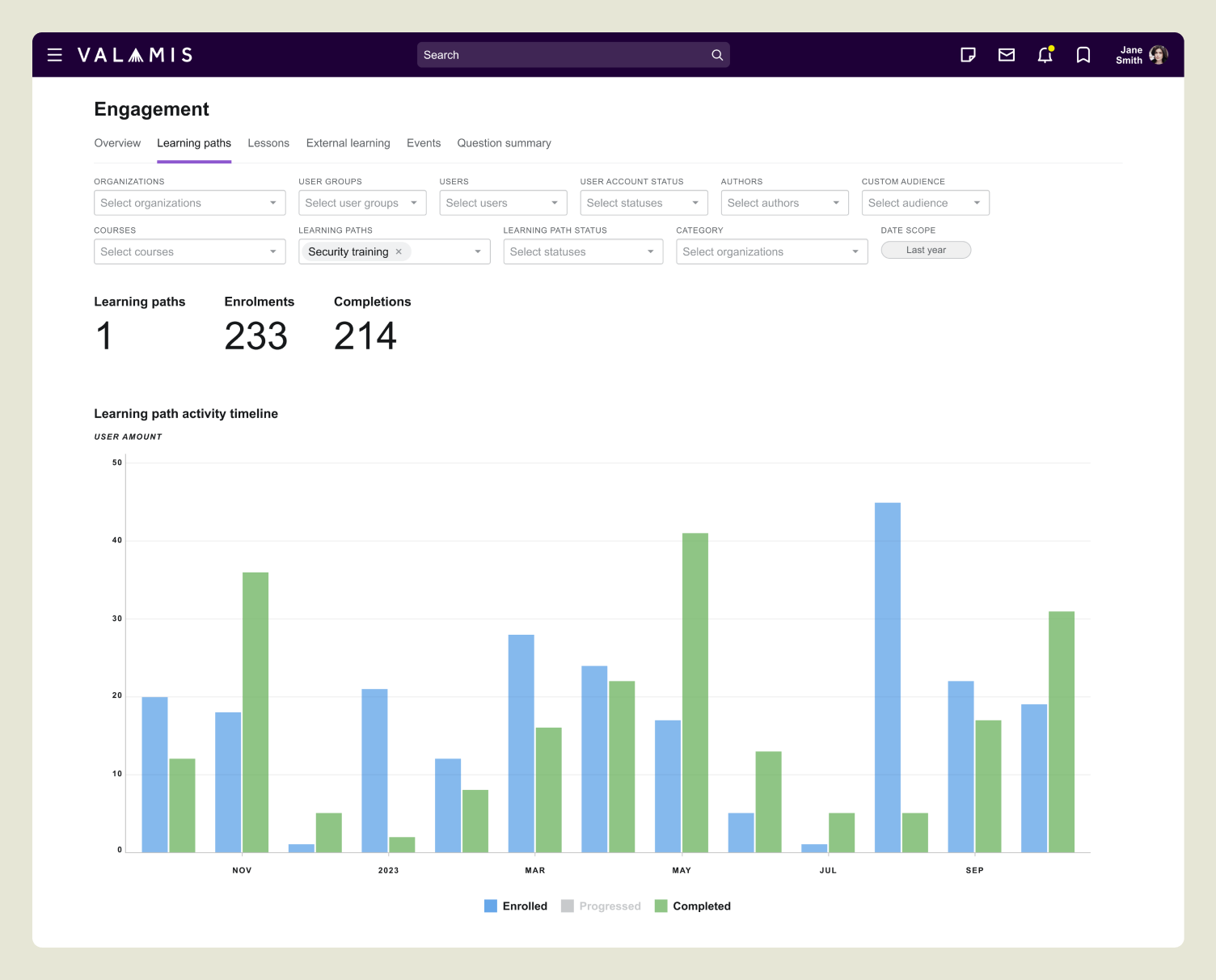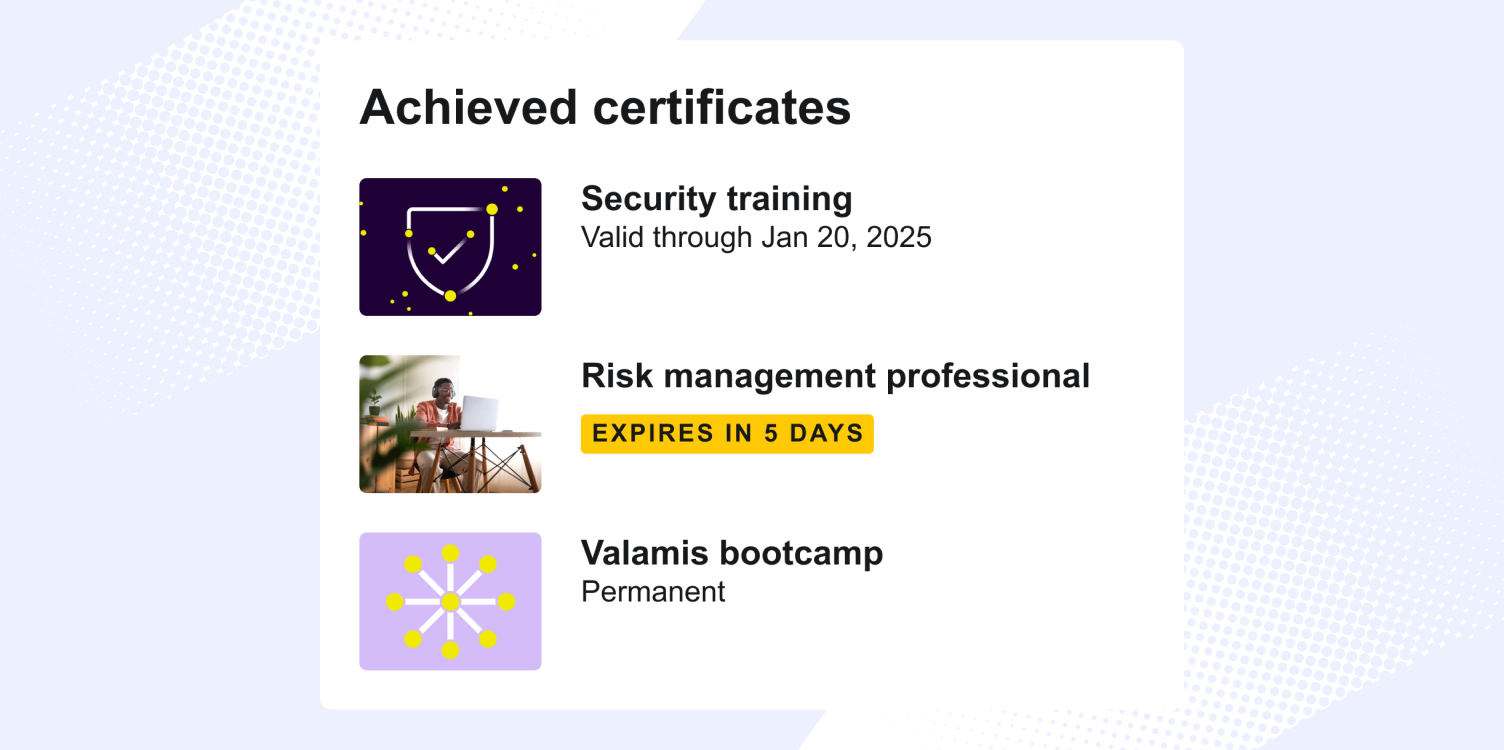Compliance training
Get a better understanding of what is a compliance training, different types and how to launch it successfully.

After reading this guide, you will better understand the importance of compliance training, and how to improve it within your organization.
Discover:
- What is compliance training?
- Examples of compliance training
- Tips and best practices for compliance training
- Online compliance training for employees
- Compliance training FAQ
What is compliance training?
Compliance training is an essential type of training designed to educate employees about an organization’s regulations, policies, and legal requirements. This training ensures that employees understand and adhere to the laws and standards that govern their workplace.
The term “compliance” signifies the obligation to accept and follow these rules, which is why compliance training is often mandatory.
It plays a critical role in safeguarding an organization’s values, upholding its policies, and maintaining its legal commitments.
Failing to comply with these mandatory requirements can lead to serious repercussions, such as termination of employment, financial penalties, criminal charges, audits, or significant damage to the organization’s reputation.
Ensuring that all employees complete compliance training by the required deadlines is crucial. This not only helps the organization maintain legal accountability but also ensures that every employee is aware of their role in protecting the organization’s integrity and success.

Compliance training checklist
Streamline your compliance training and keep your team on track with our editable PDF checklist.
Download the checklistExamples and types of compliance training
For every industry, there will be regulations that must be followed. It is in your organization’s best interest to explore compliance training for those rules, to protect both the organization as a whole and your employees.
1. Information security training
Information security training is crucial in today’s digital age, focusing on protecting an organization’s data and systems.
This training covers best practices for creating strong passwords, recognizing phishing scams, and maintaining safe internet habits. It also includes strategies to prevent social engineering attacks and secure data both within and outside the workplace, such as on mobile devices or in the event of lost or stolen equipment.
Effective information security training helps employees minimize risks that could compromise organizational security.
2. Workplace safety training
Workplace safety training is mandatory across all industries, tailored to the specific risks associated with different work environments.
In a corporate setting, this might include training on fire safety and first aid.
In contrast, in a lab or construction site, it may focus on handling hazardous materials, proper use of personal protective equipment, and safety protocols specific to that industry.
Compliance with safety regulations, such as those enforced by OSHA in the US or HSE in the UK, is critical to preventing workplace accidents and ensuring a safe environment for all employees.
3. Data protection & privacy training
With increasing regulations on data protection, such as GDPR in the EU and HIPAA in the US, data protection and privacy training have become vital.
This training educates employees on how to handle personal data responsibly, differentiate between public and private information, and respond appropriately to data breaches.
Organizations must ensure that all employees understand these regulations to protect personal data, whether it’s customer information, employee records, or third-party data.

4. Diversity training
Diversity and inclusion training is designed to promote a respectful and inclusive workplace.
It addresses unconscious biases, teaches employees how to work effectively with diverse groups, and fosters an environment where all individuals feel valued regardless of their background, gender, or abilities.
This training is increasingly important as organizations strive to build cultures that reflect the diversity of their workforce and clientele.
5. Workplace anti-harassment training
Anti-harassment training is crucial in preventing and addressing harassment, bullying, and sexual harassment in the workplace.
This training helps employees recognize inappropriate behavior and equips them with strategies to intervene or report incidents.
The importance of this training has been highlighted by high-profile cases, such as the Activision Blizzard scandal, underscoring the need for organizations to take harassment prevention seriously.
6. Healthcare training
Healthcare compliance training ensures that professionals in the healthcare industry adhere to numerous regulations, including HIPAA (mentioned earlier), the False Claims Act, and Stark Laws.
This training covers ethical standards and legal obligations, helping healthcare providers avoid legal pitfalls and maintain high standards of patient care.
Organizations must regularly update this training to keep pace with changes in healthcare regulations.
7. Export and trade compliance training
Export and trade compliance training is essential for organizations involved in international trade.
This training covers the regulations governing the import and export of goods and services, including payment transfers and the handling of both tangible and intangible assets.
Compliance with these regulations is critical to avoid legal issues and ensure smooth international operations.
8. Regulatory compliance training
Regulatory compliance training is tailored to the specific laws and regulations relevant to an organization’s industry.
For example, financial institutions may need training on regulations like FISMA in the US or the Financial Conduct Authority (FCA) guidelines in the UK and APRA in Australia.
Ensuring employees are well-versed in these regulations helps organizations avoid legal penalties and maintain their standing within their industry.
9. 508 compliance training
Section 508 compliance training is crucial for organizations that handle digital content, ensuring that information technology is accessible to people with disabilities.
This training covers creating accessible websites, using alt text for images, providing subtitles for videos, and ensuring color contrasts are appropriate.
Compliance is particularly important for federal agencies, contractors, and educational institutions to meet legal requirements and serve all users effectively.
10. HR compliance training
HR compliance training focuses on the legal aspects of the employer-employee relationship, ensuring that HR departments handle complaints and disputes fairly and consistently.
This training also helps protect organizations from potential legal challenges by ensuring that policies and procedures align with current labor laws and regulations.
11. Environmental compliance training
Environmental compliance training is essential for industries that impact the environment, such as manufacturing, petroleum, and chemicals.
This training ensures that employees understand and follow regulations like the Clean Water Act and Clean Air Act in the US or the environmental laws of the EU.
Proper training helps organizations avoid severe penalties and contribute to environmental sustainability.
12. Pharmaceutical compliance training
Pharmaceutical compliance training is vital for companies involved in the development, manufacturing, and distribution of drugs.
This training covers the regulations enforced by bodies like the the Food and Drug Administration (FDA) in the US or the Medicines and Healthcare products Regulatory Agency (MHRA) in the UK, ensuring that all stages of the pharmaceutical process meet strict safety and legal standards.
13. Insurance compliance training
Insurance compliance training is necessary for professionals in the insurance industry to understand the laws and regulations governing their field.
This training covers areas such as fraud prevention, conflict of interest, and anti-bribery laws.
Completing this training is often a legal requirement for obtaining and maintaining professional licenses in the industry.

The digital learning ecosystem workbook
You’ll get a list of useful questions and tasks to help you know your learning space better and ways to improve it.
DOWNLOAD WORKBOOKSteps for implementing online compliance training for employees
Implementing online compliance training through a Learning Management System (LMS) is an efficient way to ensure that all employees are up-to-date with necessary regulations and standards.
Below are the steps to successfully launch and manage your online compliance training program:
Identify compliance training needs
Start by identifying the specific compliance requirements relevant to your industry and organization.
This includes regulatory obligations, company policies, and any ethical standards that must be adhered to.
Based on the assessment, determine the specific topics that need to be covered, such as data protection, workplace safety, anti-harassment, and industry-specific regulations.
If you don’t have current LMS – choose the right LMS for your needs
Select an LMS that supports the features necessary for compliance training, such as tracking employee progress, issuing certificates, and providing detailed reporting.
Ensure it supports multimedia content, quizzes, and assessments. (Check Valamis as an one of the best solution for compliance)
Verify that the LMS complies with relevant eLearning standards (e.g., SCORM, xAPI) to ensure compatibility with different content formats.
Read: 10 most important LMS features
Develop or source training content
Develop custom training modules that reflect your organization’s specific policies and regulations. Use a mix of text, video, interactive elements, and case studies to make the content engaging.
If custom development is not feasible, consider purchasing pre-made compliance courses from trusted providers that are compatible with your LMS.
Tip: Include quizzes, tests, and scenarios within the training modules to assess employees’ understanding of the material.

Set up the training modules in the LMS
Upload the developed or sourced content to your LMS.
Organize it into modules or courses that align with the different compliance areas identified.
Define the criteria for course completion, such as passing grades on quizzes or mandatory viewing of all content.
Tip Set up automated reminders for employees to complete their training within the required timeframes.
Assign training to employees
Assign training modules based on employee roles, departments, and responsibilities. Tailor the training to meet the specific needs of different job functions.
Clearly communicate the importance of the training, deadlines, and any consequences of non-compliance to all employees.
Launch the training program
Launch the training program and monitor the initial participation and engagement. Address any technical issues or questions employees may have during this phase.
Tip Offer support resources, such as a helpdesk or tutorial on how to navigate the LMS and complete the training.
Track and report progress
Use the LMS reporting features to track employee progress, completion rates, and quiz scores. Identify any individuals or groups who may need additional support.
Create detailed reports that demonstrate compliance with training requirements. These reports can be used for internal audits and to satisfy regulatory obligations.

Evaluate and update training content
After the training, gather feedback from employees to understand what worked well and where improvements are needed.
Keep the training content up-to-date with any changes in regulations, laws, or company policies. Regularly review and revise the content to ensure ongoing relevance.
Issue certificates and record completion
Set up the LMS to automatically issue certificates upon course completion. Ensure these certifications are recorded in the employee’s training history.
Store all training records in the LMS for future reference and compliance audits.
By following these steps, you can successfully implement an online compliance training program using your LMS, ensuring that all employees are well-informed and that your organization remains compliant with necessary regulations.

Tips and best practices for compliance training
1. Employ digital technology
Digital technology reflects the way people engage with information and makes it easy for compliance training to be accessible and engaging.
The proliferation of training apps, cloud-based learning, and mobile learning means that ideas like microlearning or highly interactive scenario-based e-learning can be more easily created and accessed by employees.
The use of digital technology also makes updating training a lot simpler and quicker. This is an important factor for compliance training, which is often time-sensitive.
Making updates to a current course or using a cloud-based tool to quickly create a new one means that it will be pushed out to the employee immediately and also completed more quickly.
This also makes it easier to track who finished and passed the compliance training so the HR managers can react faster in case of industry audits and prevent penalties.
2. Make the training engaging
No one wants to sit and read regulations for 8 hours. Apply microlearning to keep lessons short and learners engaged.
If the training is boring, then your employees will learn very little. Keep it engaging by using simple terms, rather than technical jargon. Use snippets of rules, regulations, and laws, rather than entire dense texts.
Add in interactivity to keep learners interested. By using video, quizzes, puzzles, acting out scenarios with a partner, trivia competitions, or games, a company can keep employees engaged while also making sure that they know all of the information that is key to their role.
3. Use real-life examples
Everyone learns better when they can connect new information to knowledge that they already have.
Use real-life examples, ask learners to act out scenarios, and explore the consequences of various decisions in a risk-free environment.
4. Engage from the top down
If employees see that the leadership of their company is not following the compliance training, then they won’t either. This is precisely where ‘practice what you preach’ is the most important.
Leaders need to be seen following every part of the compliance training, publicly and consistently.
5. Encourage accountability
Assign accountability buddies, especially in situations where physical safety is at risk.
Encourage anonymous reporting as well. In cases of sexual harassment or other inappropriate behavior, this anonymous reporting system will encourage people to speak up.
Compliance training FAQ
1. Why is compliance training important?
Compliance training is essential because it helps ensure that an organization and its employees operate within legal and ethical boundaries.
This training minimizes the risk of legal issues, protects the organization’s reputation, ensures workplace safety, and promotes a culture of integrity and accountability.
2. Who needs to undergo compliance training?
All employees within an organization typically need to undergo compliance training, though the specific training required may vary depending on their role, industry, and regulatory environment.
For example, healthcare professionals may require training on patient privacy laws, while construction workers might need safety and hazard communication training.
3. How often should compliance training be conducted?
The frequency of compliance training depends on the organization’s policies and the specific regulations involved.
Some types of training, such as data protection or workplace safety, may need to be refreshed annually, while others might be required only when new laws are introduced or when an employee takes on a new role.
4. What topics are covered in compliance training?
Compliance training covers a wide range of topics, including but not limited to:
- Information security and data protection
- Workplace safety and OSHA regulations
- Anti-harassment and anti-discrimination policies
- Environmental regulations
- Industry-specific regulations, such as healthcare compliance or export controls
- Ethical standards and corporate policies
5. Is compliance training mandatory?
Yes, compliance training is often mandatory, particularly when it involves legal and regulatory requirements.
Failing to complete required compliance training can result in legal penalties for the organization, and employees may face disciplinary action or even termination for non-compliance.
6. How is compliance training delivered?
Compliance training can be delivered through various methods, including online courses, in-person workshops, webinars, and eLearning platforms (like LMS).
The choice of method depends on the organization’s resources, the complexity of the material, and the number of employees being trained.
7. What are the consequences of not completing compliance training?
Failing to complete compliance training can have serious consequences, including legal fines, audits, loss of certifications, damage to the organization’s reputation, and even criminal charges in extreme cases.
For employees, non-compliance may lead to disciplinary action, including termination.
8. How can we ensure compliance training is effective?
To ensure compliance training is effective, it should be:
- Tailored to the specific needs and risks of the organization
- Engaging and interactive to encourage participation
- Regularly updated to reflect changes in laws and regulations
- Supported by clear communication and leadership commitment
- Assessed through quizzes, evaluations, and feedback to ensure understanding
9. What is the role of management in compliance training?
Management plays a critical role in compliance training by setting the tone for a culture of compliance, ensuring that training programs are implemented effectively, monitoring employee participation, and addressing any issues of non-compliance.
Leadership support is crucial to the success of compliance initiatives.
10. Can compliance training be customized for different roles within an organization?
Yes, compliance training can and should be customized based on the specific roles and responsibilities of employees.
Different departments or job functions may face unique risks and require specialized training to address those areas effectively.

The digital learning ecosystem workbook
You’ll get a list of useful questions and tasks to help you know your learning space better and ways to improve it.
DOWNLOAD WORKBOOK



